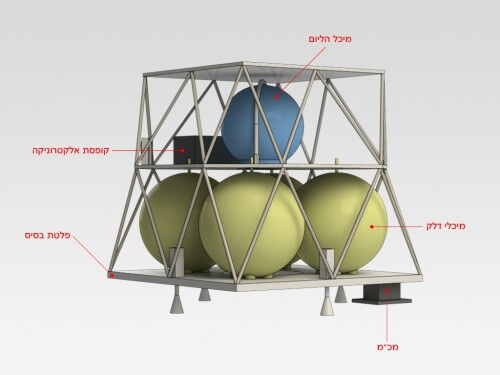The propulsion system is the most significant part of the spacecraft's components, both in the essential function it performs and in terms of its dimensions. It makes up about 80% of the spacecraft: the propulsion system, on its four fuel tanks, has a total weight of about 90 kg (when the tanks are full).

Warming up engines: the SpaceIL association is one step closer to landing on the moon and purchases a propulsion system for the spacecraft
In the contract signed this week at the MLM factory of the aerospace industry, the purchase of the most essential component of the first Israeli spacecraft that will land on the moon, towards the end of 2015, was concluded: the propulsion system.
The estimated cost of the propulsion system, which includes the four fuel tanks and the spacecraft's engines, is millions of dollars.
This is another significant progress in the hardware implementation phase, where we move from planning to practical implementation. In fact, this makes the spacecraft 'skin and tendons'. From the moment of signing the contract, the production process of the drive system parts and their assembly (integration) is expected to be completed within about a year and a half.
The propulsion system is the most significant part of the spacecraft's components, both in the essential function it performs and in terms of its dimensions. It makes up about 80% of the spacecraft: the propulsion system, on its four fuel tanks, has a total weight of about 90 kg (when the tanks are full).
These tanks should be enough for the enormous distance to the moon: about 384,000 km. The total weight of the spacecraft at takeoff will be about 140 kg in total.
SpaceIL's spacecraft is designed to be the smallest spacecraft to reach the moon. Its total size is approximately 96*72*72 centimeters (when launched). Its weight after the loss of fuel on the way will be only about 40 kg upon landing. In doing so, the SpaceIL team aims to demonstrate an innovative capability in miniaturizing technologies and building small and smart spacecraft, the cost of which is about a tenth of the cost of known spacecraft.

6 תגובות
The next project should be a probe to Mars. But it should have a state satellite. The project itself will create an infrastructure for research, experience for future projects in a variety of activities. (My humble opinion).
What about arrow 3? There should be 2 companies in existence.
I am a very small expert on engines, but any real progress in the project warms the heart.
Anonymous user (unidentified)
What's wrong with having more manufacturers of drive systems?
What a shame they didn't acquire experience and knowledge from Rafael in the development of propulsion systems for satellites, but it's a shame that they never created such a system.